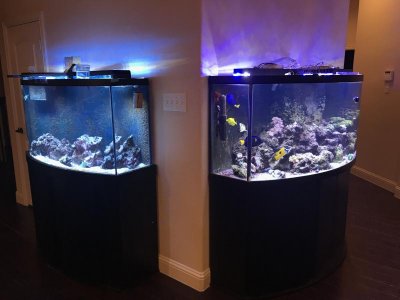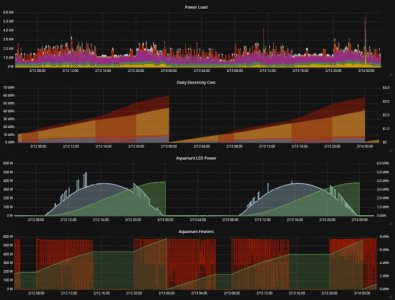Hi, I've been a member of this forum for a long time, and have been a marine aquarist for decades. However, I haven't been active on the forum much at all...
After years of neglect, I've started trying to bring my aquarium back up to its former glory. The aquarium and inhabitants are improving, but I'm trying to take it to the next level by applying some IoT expertise, and figured I would benefit from some input from you guys on some of it.
In short, I work from home, and like to have the aquarium lights on about 14 hours per day. Also, since I'm an engineer with a habit of overdoing things, my total LED power potential is above 600 watts. I'm using a mixture of cool white, royal blue, and several flavors of violet with 6 large heat sinks from RapidLED. I've also added a second aquarium that's half the size of my first, and am running it in parallel on the same filtration system.
My 180g extreme bowfront has 4 fixtures that can put out just over 400 watts, and my 90g bowfront has 2 fixtures that can put out just over 200 watts. I love the way it looks when the lights are at full power, but it's way too much light to run for the number of hours I want to run them.
So what I've done is to link the tank lights to my Phillips Hue motion sensors (via Node-Red), so that I can dim the lights (slowly) whenever no motion is detected in the room, and brighten them (quickly) whenever I walk into the room. It works extremely well, and doesn't seem to bother the inhabitants. It also seems to be reducing the algae problem I've been dealing with.
Anyway, it occurred to me that there might be some "ideal" daily kWh that I should be targeting, and just alter the distribution of those kWh's based on the motion sensors. On days that I walk through the room a lot, the lights would consumer power earlier in the day, but on days that I'm gone, the lights would consume most of the power late in the day.
It seems that using this approach might allow me to dial in an ideal amount of daily "lightage" that works best for for the inhabitants, while also getting the best visual experience.
Is this something anyone has tried? Thoughts about it? Any guesses about how many kWh / gallon I should target each day? I already have power monitoring on the circuit, so I can see instantaneous and cumulative power usage in Node-Red. I've been averaging a bit over 5 kWh per day recently (EDIT: down to 4 kWh today). When no motion is detected in the room, the total LED power output is about 250W, and when motion is detected, it climbs to 350W for at least 3 minutes. The descent from 350 to 250 is much slower than the climb.
After years of neglect, I've started trying to bring my aquarium back up to its former glory. The aquarium and inhabitants are improving, but I'm trying to take it to the next level by applying some IoT expertise, and figured I would benefit from some input from you guys on some of it.
In short, I work from home, and like to have the aquarium lights on about 14 hours per day. Also, since I'm an engineer with a habit of overdoing things, my total LED power potential is above 600 watts. I'm using a mixture of cool white, royal blue, and several flavors of violet with 6 large heat sinks from RapidLED. I've also added a second aquarium that's half the size of my first, and am running it in parallel on the same filtration system.
My 180g extreme bowfront has 4 fixtures that can put out just over 400 watts, and my 90g bowfront has 2 fixtures that can put out just over 200 watts. I love the way it looks when the lights are at full power, but it's way too much light to run for the number of hours I want to run them.
So what I've done is to link the tank lights to my Phillips Hue motion sensors (via Node-Red), so that I can dim the lights (slowly) whenever no motion is detected in the room, and brighten them (quickly) whenever I walk into the room. It works extremely well, and doesn't seem to bother the inhabitants. It also seems to be reducing the algae problem I've been dealing with.
Anyway, it occurred to me that there might be some "ideal" daily kWh that I should be targeting, and just alter the distribution of those kWh's based on the motion sensors. On days that I walk through the room a lot, the lights would consumer power earlier in the day, but on days that I'm gone, the lights would consume most of the power late in the day.
It seems that using this approach might allow me to dial in an ideal amount of daily "lightage" that works best for for the inhabitants, while also getting the best visual experience.
Is this something anyone has tried? Thoughts about it? Any guesses about how many kWh / gallon I should target each day? I already have power monitoring on the circuit, so I can see instantaneous and cumulative power usage in Node-Red. I've been averaging a bit over 5 kWh per day recently (EDIT: down to 4 kWh today). When no motion is detected in the room, the total LED power output is about 250W, and when motion is detected, it climbs to 350W for at least 3 minutes. The descent from 350 to 250 is much slower than the climb.
Last edited:


